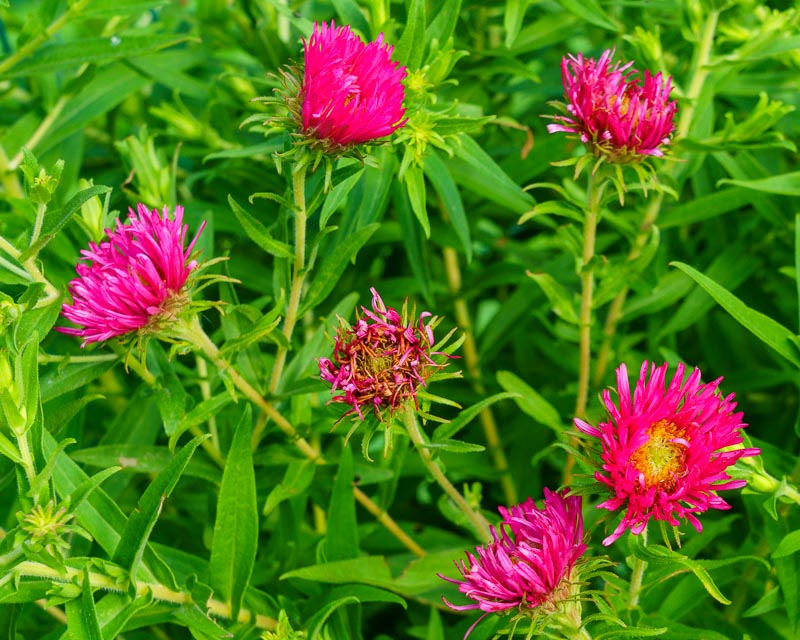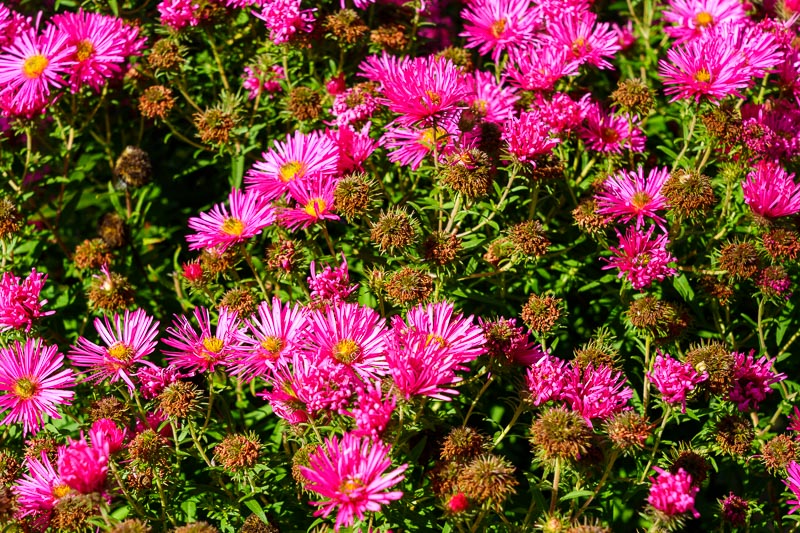Alam Potschke New England Aster
Common Name:
Alam Potschke New England Aster
Botanical Name:
Aster novae-anglia 'Alma Potschke'
Mature Size:
34” - 40” tall; 18” - 24” wide
Sun Exposure:
Full Sun
Soil Type:
Chalk, Clay, Loam, Sand
Soil pH:
Acid, Alkaline, Neutral
Bloom Time:
Late summer to fall
Flower Color:
Deep Pink
Care:
Pinch back and divide like mums for best display. General rule of thumb is to pinch until 4th of July and not after. Pinching yields better branching and more flowers. Can be divided every 2-3 years in spring. Avoid wet overwintering conditions. Remove spent flowers to prevent reseeding.
New England asters grow naturally in a variety of sites, including prairies, marshes, and forest edges. Under ideal conditions, they will easily spread in a garden bed and make excellent mass plantings. If you select a growing site that gets lots of sun and has rich soil, the asters’ care needs will be minimal. Your main task might simply be watering when there isn't enough rainfall and the soil dries out.
Soil:
These plants prefer rich soil with a slightly acidic soil pH and good drainage, but they can grow in other soil types as well. They’re even tolerant of clay soil.
Water:
Like many other flowers, New England asters like moist soil. They can tolerate lower levels of soil moisture as long as it’s not completely dry to the touch. Water your plants well during stretches with no rainfall.
Temperature and Humidity:
New England asters tend to grow vigorously throughout the climates of their USDA hardiness zones. Extremely hot weather can make the plants wilt, but they should come back fine once the temperature cools. Humidity generally isn’t an issue, though ensure that your asters will have good air circulation when planting them. Poor airflow plus high humidity can be a breeding ground for disease on plants.
Fertilizer:
Plan to fertilize your asters in the spring when new growth appears. Use a water-soluble or granular fertilizer made for flowering plants. For the amount to use, follow the product label instructions. You also can enrich the soil with compost.
Pruning:
Pinch back stems before midsummer to promote bushiness, produce a greater number of flowers and to control the plant height (to avoid flopping by the plant). Asters may self-seed if grown in ideal conditions. Cutting back after flowering will prevent undesired self-seeding.
In the first part of the summer, pinching back stems every few weeks can promote a bushier and more compact growth habit. However, stop the pinching process by August, or you might accidentally take off some flower buds. If your asters become very tall and lanky, you might need to stake them to prevent the stems from flopping over. Then, cut the asters to the ground after they're done flowering and the foliage dies in the fall. This prepares your garden bed for new growth the following spring.
Overwintering:
To help asters thrive, water the ground well before the first freeze hits. After the ground freezes, cut the asters back to the soil level and cover them with 2-3 inches of mulch.
Source:
https://www.gardenia.net/plant/aster-novae-angliae-alma-potschke-new-england-asters
https://www.thespruce.com/how-to-grow-new-england-asters-4109086


